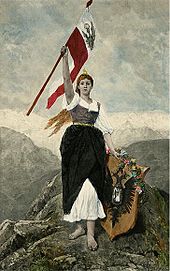Tyrolia (personification)

Tyrolia is the personification of the state of Tyrol , which was particularly depicted in the visual arts of the 19th century.
The first depictions of Tyrolia can already be found in the Baroque period , but they were not more widespread until the 19th century, especially in connection with the transfiguration of the Tyrolean struggle for freedom of 1809. A plaster sculpture by the Imst sculptor Josef Alois Dialer from around 1830 shows the winged Tyrolia with the Tyrolean coat of arms at the feet and neck and mace as a symbol of the struggle for freedom. A design by Johann Nepomuk Schaller for the tomb of Andreas Hofer depicted him resting on the sarcophagus, surmounted by the Tyrolia and St. Michael . A centerpiece by Isidor Carl Klinkosch shows the Tyrolia with a wall crown , as Andreas Hofer crowns with a laurel wreath.
The Tyrolean State Museum Ferdinandeum was founded in 1823 as the "Fatherland Museum for Tyrol". The facade of the building, which was erected in 1842–1845 and extended between 1882–1884, is crowned by a 3 meter high statue of Tyrolia, supported by a shield with the Tyrolean eagle and flanked by Minerva on the left and the Allegory of the Arts on the right. The group of sculptures designed by Joseph Gasser von Valhorn and executed by Antonio Spagnoli was erected in 1889.
While she was often depicted in an antique form, Mathias Schmid painted Tyrolia in 1890 as a young woman in traditional costume with a raised flag. As early as 1863, Schmid created the painting Austria and Tyrolia for the "German Coffee House " in Innsbruck on the occasion of the 500th anniversary of the union of Tyrol with Austria . It shows two female figures, Austria on the left with a crown and the double-headed eagle on the chest, on the right Tyrolia with a wreath of edelweiss flowers on the head, who join hands over the shield with the Habsburg double-headed eagle.
literature
- Werner Telesko: Cultural Area Austria. The identity of the regions in the visual arts of the 19th century . Böhlau Verlag, Vienna 2008, ISBN 978-3-205-77720-5 , p. 289-291 . ( PDF; 54.8 MB )
Web links
Individual evidence
- ↑ Ferdinandeum: "Tyrolia" in new splendor tirol.orf.at, October 7, 2011
- ↑ Ellen Hastaba: Program with coincidence and flaws - all-Tyrolean: the facade of the Tyrolean Provincial Museum Ferdinandeum. In: Publications of the Tiroler Landesmuseum Ferdinandeum, Volume 83 (2003), pp. 63–94 ( PDF; 224 kB )
- ^ "Tyrolia" group of sculptures on the main facade of the Tyrolean State Museum Ferdinandeum restored. ( Memento of the original from December 22, 2015 in the Internet Archive ) Info: The archive link was automatically inserted and not yet checked. Please check the original and archive link according to the instructions and then remove this notice. Archive - Short News 2011
- ↑ Helmut Wenzel: When two women announced the marriage between Tyrol and Austria. , Tyrolean daily newspaper from 7 January 2013

